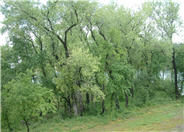
Common name:Fremont Cottonwood
Botanical name:Populus fremontii
Fremont cottonwood is a fast-growing tree, growing 50 to 60 feet tall and wide. Its bark is smooth and whitish when young, becoming brown and deeply furrowed in age. Females produce fuzzy, white cotton. Leaves are green, turning a brilliant yellow in the fall. This is a big tree, well suited to natural areas, parks, and riparian areas. Great wildlife value. A Utah native. There are male clones available that do not have cotton; some are planted at the Day-Riverside Library near the driveway entrance.
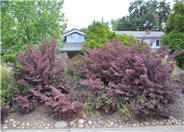
Common name:Red-leaf Japanese Barberry
Botanical name:Berberis thunbergii 'Atropurpurea'
A thorny, deciduous shrub growing 4 to 6 feet tall and as wide. Foliage emerges in spring a bright red, and matures to a dark purplish red. Bell-shaped spring flowers are followed by shiny red, torpedo-shaped fruit that persists into winter. Its purplish-red leaves contrast beautifully against a dark green background. It prefers full sun and regular watering, more in hot summer months. This is a great barrier plant.
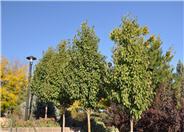
Common name:Chanticleer Flowering Pear
Botanical name:Pyrus calleryana 'Chanticleer'
‘Chanticleer’ is considered to be one of the best of the flowering pear cultivars currently available in commerce. It is a tight, narrow, pyramidal, thornless ornamental pear tree that typically grows 25 to 35 feet tall and 15 feet wide. Some specimens appear almost columnar in habit. Five-petaled, creamy white flowers in dense clusters appear in profusion in early spring. Oval, glossy dark green leaves have slightly toothed margins, and fairly dance in the breeze due to long petioles. Leaves turn attractive reddish-purple in fall. Useful in small spaces, patios, formal plantings, and as a living fence.
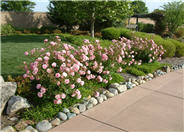
Common name:Meidiland Varieties Rose selections
Botanical name:Rosa x Meidiland Varieties
Meidiland roses are nearly ubiquitous in commercial and institutional landscapes, offering summer-long color and surprising durability for a rose. Generally growing about 1 to 2 feet tall with a spread of about 4 to 5 feet, they have a pleasant arching habit that makes them useful as a sort-of groundcover, or for cascading over walls. They do not require deadheading to remain flowering, and bloom from May to frost. Available in a variety of reds, pinks, and white. Dark green foliage and hips that ripen red in the fall, persisting into winter.
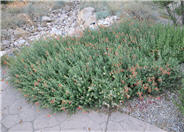
Common name:Arizona Fuchsia
Botanical name:Zauschneria arizonica
The Arizona fuchsia is a showy perennial shrub that grows 2 ft. tall with upright, erect growth habits. The large scarlet flowers are set off by the dark green foliage. This shrub is drought tolerant and attracks hummingbirds. -Cornflower Farms
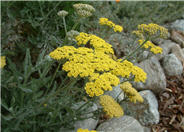
Common name:Moonshine Yarrow
Botanical name:Achillea 'Moonshine'
'Moonshine' is an upright, clump-forming, compact hybrid yarrow, with deeply-dissected, fern-like, aromatic, silvery to gray-green foliage. Flowers are long-lasting, bright lemon-yellow, and bloom throughout the summer on stiff, erect stems. This plant resembles A. 'Coronation Gold' except it is much smaller and the flowers are a lighter yellow. Grows about 18 inches tall and 24 inches wide, and seems to be slightly less invasive then other yarrow, keeping a more clumping habit. A great addition to a sunny perennial border.

Common name:Karl Foerster Feather Reed Grass
Botanical name:Calamagrostis acutiflora 'Karl Foerster'
Karl Foerster feather reed grass is a garden favorite, and for good reason. Its green, fine-textured foliage is gently arching and grows to about 2 feet tall and wide. Oat-like plumes stand very erect over the foliage, growing as tall as 5 to 6 feet. Plumes open whiteish green, later turning a dusky rose, and then tawny colored by winter. Blooms early summer with the plumes lasting into autumn. Holds its presence well into winter. Excellent in mixed perennial or shrub borders, or massed.
| Designer: Rick Laughlin | Grass Ranch 28 |
Photographer: GardenSoft |
Water Saving Tip:
Replace turf with groundcovers, trees, and shrubs. If you have areas where no one uses the grass, patches that do not grow well, or a turf area too small to water without runoff, consider replacing the turf with water-efficient landscaping.
